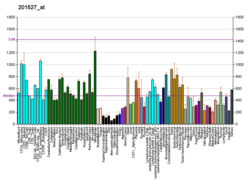ATP6V1F
V-type proton ATPase subunit F is an enzyme that in humans is encoded by the ATP6V1F gene.[5][6][7]
| ATP-synt_F | |||||||||
|---|---|---|---|---|---|---|---|---|---|
| Identifiers | |||||||||
| Symbol | ATP-synt_F | ||||||||
| Pfam | PF01990 | ||||||||
| InterPro | IPR008218 | ||||||||
| |||||||||
This gene encodes a component of vacuolar ATPase (V-ATPase), a multisubunit enzyme that mediates acidification of eukaryotic intracellular organelles. V-ATPase dependent organelle acidification is necessary for such intracellular processes as protein sorting, zymogen activation, receptor-mediated endocytosis, and synaptic vesicle proton gradient generation. V-ATPase is composed of a cytosolic V1 domain and a transmembrane V0 domain. The V1 domain consists of three A and three B subunits, two G subunits plus the C, D, E, F, and H subunits. The V1 domain contains the ATP catalytic site. The V0 domain consists of five different subunits: a, c, c', c", and d. Additional isoforms of many of the V1 and V0 subunit proteins are encoded by multiple genes or alternatively spliced transcript variants. This encoded protein is the V1 domain F subunit protein.[7]
Subunit F is a 16 kDa protein that is required for the assembly and activity of V-ATPase, and has a potential role in the differential targeting and regulation of the enzyme for specific organelles. This subunit is not necessary for the rotation of the ATPase V1 rotor, but it does promote catalysis.[8]
References
- GRCh38: Ensembl release 89: ENSG00000128524 - Ensembl, May 2017
- GRCm38: Ensembl release 89: ENSMUSG00000004285 - Ensembl, May 2017
- "Human PubMed Reference:". National Center for Biotechnology Information, U.S. National Library of Medicine.
- "Mouse PubMed Reference:". National Center for Biotechnology Information, U.S. National Library of Medicine.
- Fujiwara T, Kawai A, Shimizu F, Hirano H, Okuno S, Takeda S, Ozaki K, Shimada Y, Nagata M, Watanabe T, et al. (Mar 1996). "Cloning, sequencing and expression of a novel cDNA encoding human vacuolar ATPase (14-kDa subunit)". DNA Res. 2 (3): 107–11. doi:10.1093/dnares/2.3.107. PMID 8581736.
- Peng SB, Crider BP, Tsai SJ, Xie XS, Stone DK (Jun 1996). "Identification of a 14-kDa subunit associated with the catalytic sector of clathrin-coated vesicle H+-ATPase". J Biol Chem. 271 (6): 3324–7. doi:10.1074/jbc.271.6.3324. PMID 8621738.
- "Entrez Gene: ATP6V1F ATPase, H+ transporting, lysosomal 14kDa, V1 subunit F".
- Imamura H, Ikeda C, Yoshida M, Yokoyama K (April 2004). "The F subunit of Thermus thermophilus V1-ATPase promotes ATPase activity but is not necessary for rotation". J. Biol. Chem. 279 (17): 18085–90. doi:10.1074/jbc.M314204200. PMID 14963028.
External links
- Human ATP6V1F genome location and ATP6V1F gene details page in the UCSC Genome Browser.
Further reading
- Finbow ME, Harrison MA (1997). "The vacuolar H+-ATPase: a universal proton pump of eukaryotes". Biochem. J. 324 (3): 697–712. doi:10.1042/bj3240697. PMC 1218484. PMID 9210392.
- Stevens TH, Forgac M (1998). "Structure, function and regulation of the vacuolar (H+)-ATPase". Annu. Rev. Cell Dev. Biol. 13: 779–808. doi:10.1146/annurev.cellbio.13.1.779. PMID 9442887.
- Nelson N, Harvey WR (1999). "Vacuolar and plasma membrane proton-adenosinetriphosphatases". Physiol. Rev. 79 (2): 361–85. doi:10.1152/physrev.1999.79.2.361. PMID 10221984.
- Forgac M (1999). "Structure and properties of the vacuolar (H+)-ATPases". J. Biol. Chem. 274 (19): 12951–4. doi:10.1074/jbc.274.19.12951. PMID 10224039.
- Kane PM (1999). "Introduction: V-ATPases 1992-1998". J. Bioenerg. Biomembr. 31 (1): 3–5. doi:10.1023/A:1001884227654. PMID 10340843.
- Wieczorek H, Brown D, Grinstein S, et al. (1999). "Animal plasma membrane energization by proton-motive V-ATPases". BioEssays. 21 (8): 637–48. doi:10.1002/(SICI)1521-1878(199908)21:8<637::AID-BIES3>3.0.CO;2-W. PMID 10440860.
- Nishi T, Forgac M (2002). "The vacuolar (H+)-ATPases--nature's most versatile proton pumps". Nat. Rev. Mol. Cell Biol. 3 (2): 94–103. doi:10.1038/nrm729. PMID 11836511.
- Kawasaki-Nishi S, Nishi T, Forgac M (2003). "Proton translocation driven by ATP hydrolysis in V-ATPases". FEBS Lett. 545 (1): 76–85. doi:10.1016/S0014-5793(03)00396-X. PMID 12788495.
- Morel N (2004). "Neurotransmitter release: the dark side of the vacuolar-H+ATPase". Biol. Cell. 95 (7): 453–7. doi:10.1016/S0248-4900(03)00075-3. PMID 14597263.
- Cross SH, Charlton JA, Nan X, Bird AP (1994). "Purification of CpG islands using a methylated DNA binding column". Nat. Genet. 6 (3): 236–44. doi:10.1038/ng0394-236. PMID 8012384.
- Strausberg RL, Feingold EA, Grouse LH, et al. (2003). "Generation and initial analysis of more than 15,000 full-length human and mouse cDNA sequences". Proc. Natl. Acad. Sci. U.S.A. 99 (26): 16899–903. doi:10.1073/pnas.242603899. PMC 139241. PMID 12477932.




